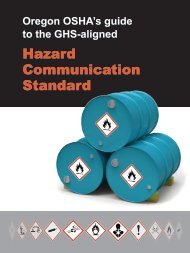Technical Manual - Section 3 (Safety Hazards)
Technical Manual - Section 3 (Safety Hazards)
Technical Manual - Section 3 (Safety Hazards)
You also want an ePaper? Increase the reach of your titles
YUMPU automatically turns print PDFs into web optimized ePapers that Google loves.
<strong>Safety</strong><br />
Automatic or manual shutoff systems at supply headers are<br />
needed for top and bottom loading in the event of leaks or<br />
overfills. Fall protection such as railings are needed for<br />
top-loading racks where employees are exposed to falls.<br />
Drainage and recovery systems may be provided for storm<br />
drainage and to handle spills and leaks. Precautions must be<br />
taken at LPG loading facilities not to overload or<br />
overpressurize tank cars and trucks.<br />
Health<br />
The nature of the health hazards at loading and unloading<br />
facilities depends upon the products being loaded and the<br />
products previously transported in the tank cars, tank trucks,<br />
or marine vessels. Safe work practices and/or appropriate<br />
personal protective equipment may be needed to protect<br />
against hazardous exposures when loading or unloading,<br />
cleaning up spills or leaks, or when gauging, inspecting,<br />
sampling, or performing maintenance activities on loading<br />
facilities or vapor-recovery systems.<br />
TURBINES<br />
Turbines are usually gas- or steam-powered and are typically<br />
used to drive pumps, compressors, blowers, and other refinery<br />
process equipment. Steam enters turbines at high<br />
temperatures and pressures, expands across and drives<br />
rotating blades while directed by fixed blades.<br />
HEALTH AND SAFETY CONSIDERATIONS<br />
<strong>Safety</strong><br />
Steam turbines used for exhaust operating under vacuum<br />
should have safety relief valves on the discharge side, both<br />
for protection and to maintain steam in the event of vacuum<br />
failure. Where maximum operating pressure could be greater<br />
than design pressure, steam turbines should be provided with<br />
relief<br />
devices. Consideration should be given to providing<br />
governors and overspeed control devices on turbines.<br />
Health<br />
Safe work practices and/or appropriate personal protective<br />
equipment may be needed for noise, steam and heat<br />
exposures, and during inspection and maintenance activities.<br />
PUMPS, PIPING AND VALVES<br />
Centrifugal and positive-displacement (i.e., reciprocating)<br />
pumps are used to move hydrocarbons, process water, fire<br />
water, and wastewater through piping within the refinery.<br />
Pumps are driven by electric motors, steam turbines, or<br />
internal combustion engines. The pump type, capacity, and<br />
construction materials depend on the service for which it is<br />
used.<br />
Process and utility piping distribute hydrocarbons, steam,<br />
water, and other products throughout the facility. Their size<br />
and construction depend on the type of service, pressure,<br />
temperature, and nature of the products. Vent, drain, and<br />
sample connections are provided on piping, as well as<br />
provisions for blanking.<br />
Different types of valves are used depending on their<br />
operating purpose. These include gate valves, bypass valves,<br />
globe and ball valves, plug valves, block and bleed valves,<br />
and check valves. Valves can be manually or automatically<br />
operated.<br />
HEALTH AND SAFETY CONSIDERATIONS<br />
Fire Protection and Prevention<br />
The potential for fire exists should hydrocarbon pumps,<br />
valves, or lines develop leaks that could allow vapors to reach<br />
sources of ignition. Remote sensors, control valves, fire<br />
valves, and isolation valves should be used to limit the release<br />
of hydrocarbons at pump suction lines in the event of leakage<br />
and /or fire.<br />
III:2-56
















